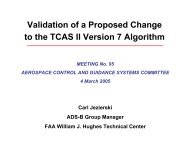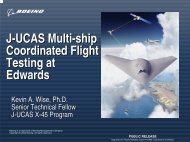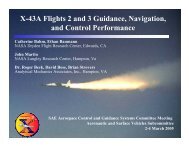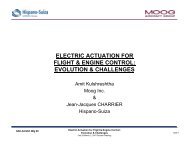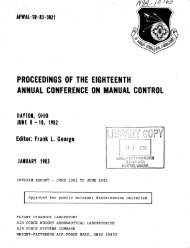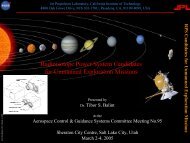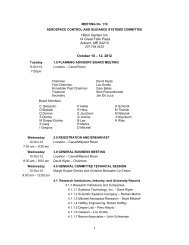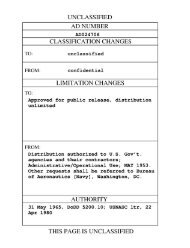Report of the Second Piloted Aircraft Flight Control System - Acgsc.org
Report of the Second Piloted Aircraft Flight Control System - Acgsc.org
Report of the Second Piloted Aircraft Flight Control System - Acgsc.org
Create successful ePaper yourself
Turn your PDF publications into a flip-book with our unique Google optimized e-Paper software.
eutione, <strong>the</strong> aerodynamics and <strong>the</strong> contrdl stiok dynamicre If <strong>the</strong> phugoid<br />
motion and very low frequency behavior is neglected, <strong>the</strong> a-cr<br />
behaver essmtially as a sewnd-order rgrstem, with a tranefer f'unction<br />
<strong>of</strong> <strong>the</strong> form ahom in SQ. 1. The relative damping ratio assoaicrted wlth<br />
<strong>the</strong> conJugete pole8 here ir in our arample about 0.4. At'high apwds,<br />
this relative damping ratio could be axpected to go or low as 0.1 or lesr.<br />
Additional phaae lag is introduced in <strong>the</strong> uontrol stick dynamics, <strong>the</strong><br />
medwiaal vtan frm <strong>the</strong> control otick to <strong>the</strong> input to <strong>the</strong> hydraulic<br />
~grrt-. The ~grutm wr ere oonaidaring here ir ahom in Fig. 3 atxi ha8<br />
en rppmxbate tranafer funotion af <strong>the</strong> form: -<br />
The overall open-loop systsm th& has a transfer function proportional<br />
to <strong>the</strong> product <strong>of</strong> <strong>the</strong>se two individual functions.<br />
K<br />
Sfs+8.Z)(sZ+ 7:l.s tC3)<br />
The corresponding pole configuration for <strong>the</strong> open-loop wstem is <strong>of</strong> <strong>the</strong><br />
fom shown in Pigo 10.<br />
We now consider what happens as we close <strong>the</strong> loop and bring up <strong>the</strong> loop<br />
gain from a very low value. The poles <strong>of</strong> <strong>the</strong> closed-loop transfer function<br />
move in <strong>the</strong> maaner shown in Fig. U. For relatively low values <strong>of</strong> loop gain,<br />
<strong>the</strong> closed-loop system is unstable. How can this ~syotem be stabillzed? In<br />
particular, haw can <strong>the</strong> system be stabilized at a value <strong>of</strong> loop gain vrNch<br />
is mfficie~lrtly high to insure that we have adequate control characteristics?<br />
The first and mgot obvious method is to introduce a device to cut <strong>the</strong> qotem<br />
<strong>of</strong>f, at least part way, at very low frequenciee-a device which <strong>the</strong> electronic<br />
engineer wuuld term integral control. Such a device necessarily tends, as<br />
we saw earlier, huuever, to decrease <strong>the</strong> speed <strong>of</strong> response <strong>of</strong> <strong>the</strong> system. We<br />
have felt that <strong>the</strong> primary Job <strong>of</strong> any stabilization that is introduced should<br />
be to force <strong>the</strong> airplane to respond more rapidly than <strong>the</strong> aerodynamical<br />
uoefficients would ordinarily allow. Certainly, at least, thq stabilization<br />
system should not make <strong>the</strong> system more sluggish.<br />
Considering this pole configuration, one possibility is irmnediately<br />
evident. We might attempt to move <strong>the</strong> pole due to <strong>the</strong> stick dynamics, wr<br />
at-8.2, so far out into <strong>the</strong> l&-half plane that <strong>the</strong> system essentially<br />
reduces to a third-order ri<strong>the</strong>r than a f ourth-order system. This can be<br />
readily accomplished as shoun in Fig. U simply by an increase in <strong>the</strong> value<br />
<strong>of</strong> <strong>the</strong> damping.coeffic5mt fp. There are two difficulties that arise at<br />
once however, with such a scheme <strong>of</strong> partial stabilization. Flrst, <strong>the</strong> force<br />
-<br />
required <strong>of</strong> <strong>the</strong> pilot to move <strong>the</strong> stick at a constant velocity, when he is<br />
moving essentially against this damper, increases intolerably. <strong>Second</strong>ly,<br />
<strong>the</strong> time lag betwleen <strong>the</strong> stick and <strong>the</strong> output <strong>of</strong> <strong>the</strong> hydraulic ~ s t e ~<br />
increases proportional to this damping coefficient. In particular, this<br />
time lag, assuming <strong>the</strong> hydraulic system acts instantaneously, is given tgr<br />
<strong>the</strong> ratio <strong>of</strong> <strong>the</strong> damping coefficient, fp, to <strong>the</strong> spring constant <strong>of</strong> <strong>the</strong><br />
push-rod, k, as is shown in appendix A. Thus, about <strong>the</strong> beet we can do



